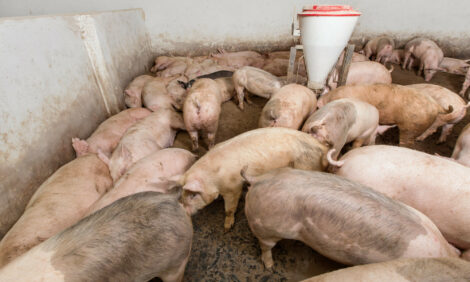



US Swine Mating Practices: A Summary
By USDA NAHMS - The USDA’s National Animal Health Monitoring System (NAHMS) collected data on swine health and management practices from a random sample of swine production sites in 17 states 1 as part of the Swine 2000 study. These sites represented 94 percent of the U.S. pig inventory and 92 percent of U.S. pork producers with 100 or more pigs. This article reports on the study's findings on Mating Procedures.
Overall, 2,499 swine production sites participated in the first interview from June 1, 2000, through July 14, 2000.
For estimates in this report, small, medium, and large sites refer to sites with less than 250, 250 to 499, and 500 or more breeding females, respectively. Animal-level estimates reported here are based on a June 1, 2000, inventory.
Swine Mating Practices

|

|
Reproductive performance is an integral part of pork
production. Farrowing rates and litter size can be
affected significantly by mating practices; therefore,
proper mating techniques are essential for optimum
reproductive efficiency.
Often, breeding females are mated more than once
during their estrous cycle/heat period. The study
indicated that the majority of sows (50.9 percent) and
gilts (47.3 percent) were mated twice during an
estrous cycle (Figure 1). More than one-fourth of all
sows and gilts were mated three or more times per
service.
Mating techniques used to breed sows and gilts varied
by size of site. Pen-mating was used most commonly
on small sites (84.4 percent), compared to large sites
(6.4 percent). Artificial insemination was used for
mating sows and gilts on 91.3 percent of large sites
(Figure 2).
Although artificial insemination was used on only
23.2 percent of all sites, more breeding females were
bred using artificial insemination than any other
technique because more large sites (91.3 percent) used
this technique than medium (61.4 percent) or small
(12.1 percent) sites. Overall, 68.6 percent of sows and
64.5 percent of gilts were on sites where artificial
insemination was the predominant mating technique
for the first mating. Similarly, 72.3 percent of sows
and 65.7 percent of gilts were on sites where artificial
insemination was the predominant mating technique
for the second mating (Figure 3).
Semen was purchased by 72.9 percent of sites that
used artificial insemination. Only 17.1 percent of sites
using artificial insemination actually collected and
processed semen on-site. Semen was collected and
processed off-site (e.g., owner, boar-stud) by 20.8
percent of sites using artificial insemination. (Note:
some sites obtained semen from multiple sources;
therefore, the values mentioned above sum to more
than 100 percent). More sites in the Southern region
collected semen off-site than did sites in the West
Central, Northern, and East Central regions
(Figure 4).
Sites that used artificial insemination as the
predominant mating technique averaged 10.7 total
pigs born per litter, compared to 9.9 total pigs born
per litter for sites using other techniques. The
percentage of breeding females culled for reproductive
failure was higher on sites where artificial
insemination was the predominant mating technique
(23.3 percent of culls), as compared to other
techniques (15.8 percent of culls).
Breeding records were kept by over three-fourths of
sites with gestation and farrowing phases. These
records were kept more often on large (96.8 percent)
and medium (96.3 percent) sites than on small sites
(72.2 percent).
Although 78.1 percent of sites were visited by a
veterinarian during the previous 12 months, only 7.1
percent of these sites used a veterinarian for artificial
insemination or breeding evaluations. Generally, a
veterinarian was used more often for artificial
insemination and/or breeding evaluations as site size
increased (5.3 percent of small sites; 28.7 percent of
medium sites; and 42.7 percent of large sites).

All the Reports in the Series (to date)
The full set of NAHMS articles from the Swine 2000 Report are available on this web site as follows:- US Feed Management of Swine: A Summary
- US Swine Mating Practices: A Summary
- US Swine Herd Summary: Swine Health and Environmental Management
- US Gilt Management: A Summary
- US Swine Nursery Management: A Summary
- US Swine Parasite Management: A Summary
- US Swine Herd Summary: Disease Problems and Antimicrobial uasge
- Administration of Iron and Antibiotics on US Hog Farms: A Summary
For more information, contact:
Centers for Epidemiology and Animal Health
USDA:APHIS:VS:CEAH
NRRC Building B., Mail Stop 2E7
2150 Centre Ave.,
Fort Collins, CO 80526-8117
(970) 494-7000
[email protected]
www.aphis.usda.gov/vs/ceah/cahm
Source: USDA National Animal Health Monitoring Service - September 2002 (released Jan 2003)








